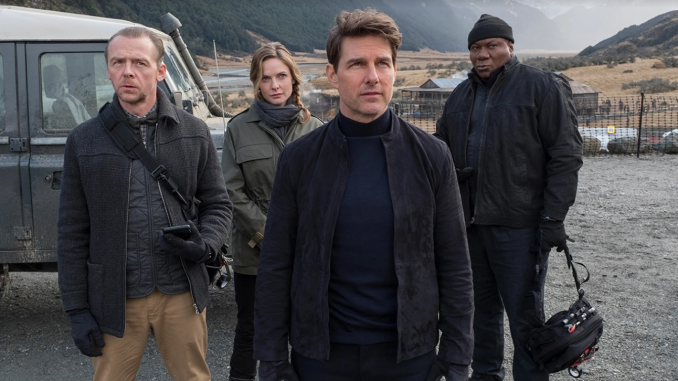
By Shea Stevenson
A confession: I haven’t seen the original “Mission Impossible” show. Statistically speaking, you haven’t either, so let’s ignore it. I have seen every “Mission Impossible” movie however, and it’s burdened me with strong opinions on the many quiet deaths of the franchise. I’m not here to talk about stunts or Tom Cruise, those are the average topics with these movies and I have nothing to add. I’m here to talk about the most structurally unique blockbuster franchise in American history.
Death number one is obvious, and I’ll skip it: the show ended. My dad says it was good.
Death number two is the most natural a film can have: the first “Mission Impossible” movie doesn’t know it’s the foundation for seven other movies, so it ends! What a lot of people either forget or don’t realize is that it’s directed by Brian Depalma, a noted weirdo and art house darling (directed movies like “Sisters” and “Blowout”). At first blush, that’s strange. What’s he doing fronting a huge blockbuster action movie? But then you watch it and you realize A) It’s a spy movie, not an action movie. And B) Yes, it is a thoroughly strange blockbuster.
For the start of a franchise that went on to exclusively use popular contemporary cinematic techniques, this movie is fixated on 60s and 70s cinema. From the giallo-like lighting, to gadgets ripped from retro futurist movements, to the shockingly down-to-earth set pieces (save for the coup de gras, of course), this is easily one of the widest outliers in the franchise. It lived well, and died as it lived.
Death number three is a terrible accident. “Mission Impossible 2” is directed by Hong Kong action legend John Woo, and is widely regarded as one of the series’ worst outings. As both a contrarian and Woo-head myself, it pains me to say that this movie is indeed terrible. It boldly casts aside practically everything set up in the first movie and goes full tilt into action, as one should expect from Woo. The problem is that in needing the “Mission Impossible” name, it compromises its most interesting Woo-isms in pursuit of continuity, yet even so never manages to feel like “Mission Impossible.” What we’re left with is a Frankenstein of ideas that never quite comes to life.
The last two deaths were the products of strong directorial visions. They had an idea, they executed it to varying degrees of success, and then that vision was finished. So a solution arises: a movie without novel directorial vision.
Death number four must have looked like a butterfly hatching from a chrysalis corpse to the moneymen. J.J. Abrams steps in to direct the third movie, and if you don’t know anything about J.J Abrams, he’s most famous for directing most of the new “Star Trek” and “Star Wars” reboot movies. His specialty is showing up and being pointed in a direction, and he’s doing his job. With “Mission Impossible 3,” Abrams did a contemporary action espionage movie without inspiration beyond blockbuster entertainment. This is 2006, so we’re talking high contrast, high saturation, shaky cam, gritty battle scenes, etcetera. More than any other, this movie defines the direction of the franchise we know today. As a contrarian and art house enjoyer, it pains me to say that this is easily my favorite one.
But the third movie is not the one that marks the fourth death, that honor goes one down. The fourth movie is a reification of the elements set up by the third; its characterization for the main character, its focus on stunts, its intense tone, all come back for the fourth in one way or another. This is why it marks a franchise death. The time of probing for constant reinvention is over. With the fourth, they lock themselves into a niche of action cinema that previously they had been pacing around. From here on out, “Mission Impossible” knows precisely what it is.
Such is the fate of all franchises that last so long. The paradox arrives: if you had a new idea, why would you make a franchise film? If it makes money, why wouldn’t you?
The fifth death of “Mission Impossible” has yet to come. With a seventh movie on the way, part one of a two-part production to cap off the franchise, I’m concerned for the quality of these movies. Doubts must be cast given the age of its star and the state of the sixth outing (regarded by most to be a highlight of the franchise, I say it’s borderline unwatchable) along with that putrid Hollywood trend of splitting the final installment into two movies.
In its greedy cowardice, staying the same for so long, “Mission Impossible” illuminates the framework that studios use to maintain a blockbuster franchise. It bounced from vision to vision until it found the straight-shooters who showed the way to an actionable, repeatable structure. So the movies are made until the money stops coming. And that’s not to mention that it all works great as propaganda for U.S. intelligence agencies.
But then again, I’ll be in the theater for number seven on opening night so what do I know? If you haven’t seen these movies, go: first, third, fourth, fifth and spare yourself of the second and sixth movies. I don’t have enough words for a ‘this article will self destruct’ joke. Get out of here.
